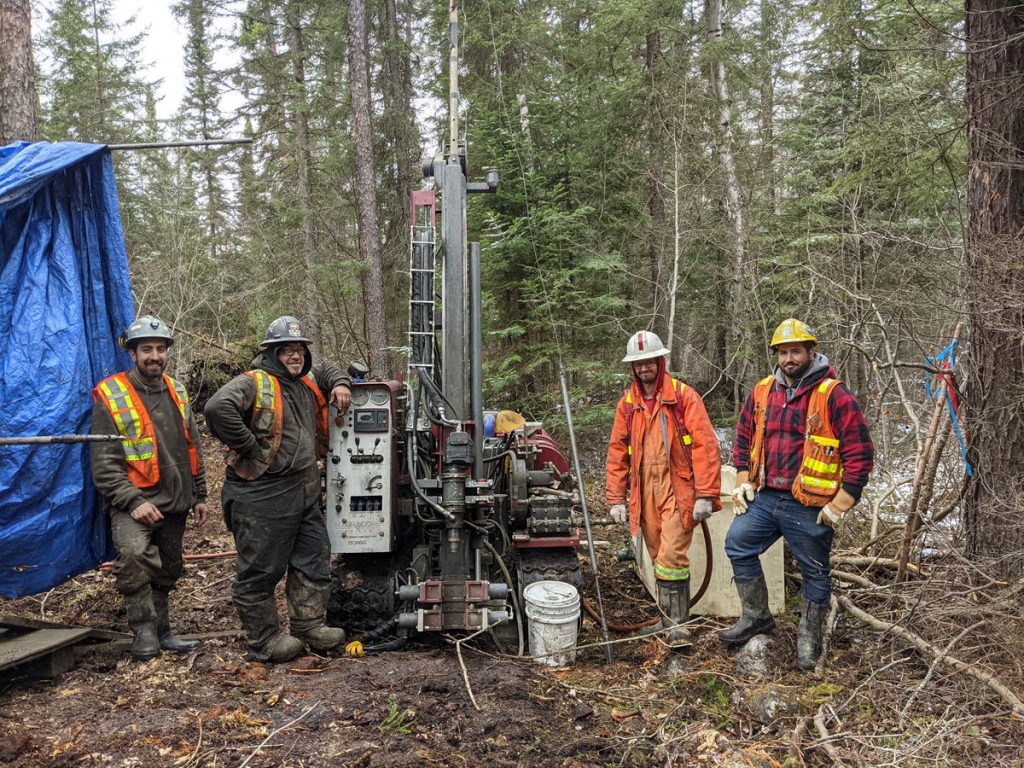GT Resources drills 0.04% nickel over 24.3 metres at Tyko II, Ontario

GT Resources Inc. [TSXV-GT; OTCQB-NKORF; FSE-7N11] reported final results from the 2023 drill program on the Tyko II property, which forms part of the larger Tyko nickel-copper project in Ontario, Canada.
Highlights: Represents GT’s first drill testing on the Tyko II property; massive sulphide was intercepted at the base of the Moshkinabi intrusion, thereby supporting the prospectivity for additional massive sulphide mineralization at Tyko II. Drilling returned 0.8% nickel and 0.6% copper over 0.7 metres, including 0.9% Ni and 0.6% Cu over 0.4 metres in hole TK23-141.
Also intersected was disseminated copper-palladium-rich mineralization, within the Kejimalda zone, which represents an additional style of mineralization and further supports the prospectivity of the area.
Drilling returned 0.1% Cu and 0.33 g/t TPM (platinum plus palladium plus gold) over 24.3 metres, including 0.23% Cu and 0.73 g/t TPM over two metres in hole TK23-142. The Kejimalda zone extends over a 3-km strike length and ranges in width from a few metres up to 30 metres in width.
In Q4 2023, 3,028 metres were drilled in 22 diamond drill holes on the Tyko project, 12 holes were drilled on the Tyko I property and 10 on the Tyko II property, which are detailed in this release.
The Gionet zone has returned up to 0.38% Cu in soils coincident with VTEM (versatile time domain electromagnetic) anomalies and remains to be drill tested following receipt of exploration drill permits.
“The first drilling on the Tyko II property has returned encouraging results including up to 0.9% Ni in massive sulphide. The drill program was focused on the Moshkinabi intrusion which is the best mapped and hence understood part of the wider Faries-Moshkinabi mafic-ultramafic complex. Large parts of this intrusive complex remain untested, notably the Gionet Zone which has demonstrated strong copper and nickel soil anomalies coincident with VTEM anomalies. Plans are underway to further explore this large mafic-ultramafic complex once additional Exploration Permits are received,” stated Derrick Weyrauch, President and CEO.
The 2023 drill program comprised 22 holes totalling 3,028 metres on both the Tyko I and Tyko II Properties. The program included twelve holes targeting the West Pickle area of Tyko I and 10 drill holes on the Tyko II Property, primarily targeting the Moshkinabi intrusion. Drilling on the Moshkinabi intrusion targeted both massive and disseminated sulphides.
The primary drill target was massive sulphide mineralization along the base of the intrusion such as that found in a historic trench which returned grab samples up to 1.0% Ni, 0.2% Cu, 0.13% Co, 2.42 g/t Pd, and 0.15 g/t Pt. A 2023 VTEMmax survey outlined several isolated conductors located near the base of the Moshkinabi intrusion which could represent additional massive sulphide accumulations. Holes TK23-140 and 141 successfully intersected Ni-rich semi-massive and massive sulphide similar to the grab samples from the historic trench, however several other holes intersected highly deformed sulphide facies banded iron formation in the volcanic wall rock to the Moshkinabi intrusion. This style of mineralization warrants additional follow up.
The secondary target was disseminated Cu-Pd-rich mineralization higher up in the Moshkinabi intrusion belonging to the Kejimalda Zone, which has been defined by historical mapping and prospecting over three kilometres of strike length. Disseminated style mineralization was intersected in six holes with widths ranging from two to 24 metres. The disseminated style mineralization appears to parallel the lower contact of the intrusion, which dips shallowly the northeast, and could represent a reef-style system.
The final hole of the program TK23-144 targeted an isolated VTEM anomaly and intersected semi-massive pyrrhotite-rich mineralization with minor chalcopyrite in highly deformed volcanics. It is thought to be volcanogenic massive sulphide (VMS) style mineralization with potential similarities to the nearby world-class Geco mine that produced over 49.3 Mt of ore grading 1.85% Cu, 3.78% Zn, and 56.2 g/t Ag (Puumala et al., 2020).
The Tyko nickel-copper project is located approximately 65 km northeast of Marathon, Ontario. Tyko is an early stage, high sulphide tenor, nickel – copper (2:1 ratio) project and with multiple mineralized zones spanning over a 20-km strike length and demonstrating the potential for a new greenfield nickel-copper district.
GT Resources also announces that its board of directors has granted 650,000 restricted share units (RSUs) to certain employees, advisors and consultants which vest in three years from the date of issue and have a term of 5-years; 3,000,000 deferred shares units (DSUs) to certain officers and directors, which are exercisable upon departure from the Company and which vest immediately; 3,825,000 stock options to certain officers and directors, which are exercisable for five years at a price of $0.05 per common share with 1/3rd vesting immediately and 1/3rd every 6-months thereafter; and and 725,000 stock options to certain employees, advisors and consultants, which are exercisable for five years at a price of $0.05 per common share with 1/3 vesting immediately and 1/3 every 6-months thereafter.
GT Resources is targeting district scale, nickel-copper sulphide and platinum-group-element deposits in Canada and Finland. The Lantinen Koillismaa (LK) Project in north-central Finland, is a PGE-copper-nickel project that has existing NI 43-101 Mineral Resources, while both the Tyko and Canalask high-grade nickel-copper projects are located in Ontario and the Yukon, Canada, respectively.
